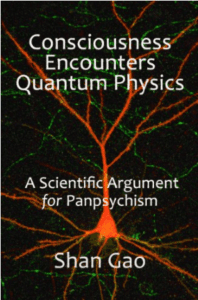Do quantum particles have free will? Can they make choices? Some physicists have considered this question seriously. But why? One reason might be that if quantum particles have free will, it would solve one of the riddles of their behavior. In many accepted interpretations, some aspects of quantum particle behavior are random. That is, no prior cause determines the behavior; the behavior just pops out of nowhere.
Example of a Particle Possibly Exercising Free Will

This may be one of the reasons that some physicists take an interest in the question of whether quantum (subatomic) particles have free will.
In 2006, two physicists, John H. Conway and Simon B. Kochen, published a famous paper on the question in the prestigious journal, Foundations of Physics. In this paper, they presented the Conway-Kochen Free Will Theorem. This theorem states that if the human experimenters have free will, then the quantum particles that they are experimenting upon must necessarily have free will.
To explain: If the experimenters don’t have free will, their choices are completely determined by the history of the universe up to the moment of the experiment. If we only knew all the factors affecting the decisions of the experimenters, we could completely explain and predict their decisions as to how to do the experiment. Their behavior is completely determined by earlier causes, and they have no free will.
However, if the experimenters have free will, their behavior is not completely the result of prior causes. The experimenters initiate something new—they make a free choice.
The Conway-Kochen Free Will Theorem says that if the experimenters are able to exercise free will in regard to how the experiment is done, then it logically follows that the quantum particles in the experiment also have free will.
I’m not presenting why the free will of the quantum particle logically follows because I don’t understand it myself. But, the logic makes sense to a number of physicists, and the theorem continues to be be under discussion.
Conway-Kochen Freewill Theorem
If quantum particles have free will, it implies that they have consciousness. That is, they are not inert matter but, like us, have a mind which can make decisions. Some quantum physicists believe that this is the case. Freeman Dyson, one of the most important quantum physicists of the 20th Century, is among them. Dyson wrote:
“Matter in quantum mechanics is not an inert substance but an active agent, constantly making choices between alternative possibilities…. It appears that mind, as manifested by the capacity to make choices, is to some extent inherent in every quantum particle.” (Infinite in All Directions, 1988, p. 297).
The quantum physicist, Ruth E. Kastner, speculates along similar lines:
“Is there a volitional basis for actualization?…Does nature then express a certain volitional capacity? Or, put another way, could such an uncaused ‘choice’ be seen as evidence of the creativity of nature?” (Understanding Our Unseen Reality, Solving Quantum Riddles, Imperial College Press, London, 2015; p. 73)
Panpsychism and the Free Will Theorem


Panpsychism fell out of favor in the middle of the 20th Century. But as contemporary philosophers and psychologists grapple with understanding consciousness, some are expressing renewed interest in the idea that matter, itself, is conscious. For example, David Chalmers and Galen Strawson are philosophers who speak and write extensively about panpsychism. Donald Hoffman, a neuroscientist, and Rupert Sheldrake, a biologist, also discuss panpsychism extensively.
Do individual electrons actually make decisions?
It may be hard to imagine an electron having the thought, “I think that I’ll spin clockwise now.” Henry Stapp, the eminent quantum physicist, has suggested an alternative scenario. He notes that there is considerable experimental evidence that quantum particles behave non-locally. That is, when entangled, particles act as though they are “at-one with” their entangled partner. They do not behave as separate individualized particles but rather as an integral part of a larger whole–the twosome. In fact, the same equation (wave function) is used to describe both particles. Stapp suggests that quantum particles behave in response to the free will of Nature.
Stapp seems to suggest that Nature choreographs the behavior of all quantum particles, not only the partner of an entangled pair. Some physicists have proposed that all quantum particles are entangled with each other because their ultimate constituents shared the same spacetime at the moment of the Big Bang. In addition, in Stapp’s proposal, Nature appears to be a causative agent with a mind of her own. Without suggesting that Stapp is a supporter of the Gaia Hypothesis, his proposal aligns with aspects of this hypothesis. The Gaia Hypothesis, was developed by chemist, James Lovelock, and microbiologist, Lynn Margulis, in the 1970’s. In brief, they propose that all the organisms and inorganic parts of the Earth function in an integrated manner as if they are one big “superorganism.”
So, do quantum particles have free will?
This, like many aspects of quantum mechanics, is debatable. Of course, the question as to whether human beings have free will is also debatable.
Most quantum physicists probably don’t think about nor care about the issue of the free will of quantum particles. They carry out their experiments without thought as to whether the quantum particles they the shoot from quantum particle guns are conscious. Or they work the mathematics of quantum mechanics to design the computers that have revolutionized our lives, not dwelling on the issue of consciousness. They are able to get results from quantum mechanics without thinking deeply about the philosophical underpinnings of the field.
But for those physicists and those of the rest of us who want to understand what’s really going on, this is an intriguing question. It has huge implications for why we’re here, where we came from, what we’re supposed to be doing, and where we are going to go.
*There are also other situations in which subatomic particles display what appears to be uncaused, random behavior.
